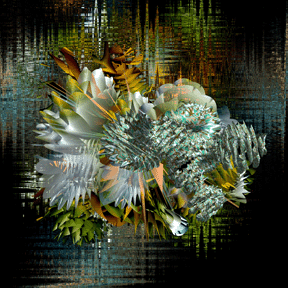
Winnie the Pumpernickel

The client asked me, "What is this new work all about?"
"I don't know", I replied. "It just pours out".
That's not really fair, is it? Artists are expected to verbalize as well as create. (If I were a verbalizer I'd be writing novels, mysteries, poetry.)
But these are my novels, mysteries, and poetry, written in color, shape, pattern and space. Just because the alphabet is a bit different, it's important to know what's being communicated.
The client ventured, "explosion out of constraint".
An artist friend saw "transformation".
A curator mentions "ornamentation". Natasha Kurchanova writes, "The first attribute of ornament as art that distinguishes it from its limited and subordinate application in design is the vitality and expressive energy of visual form. Here, decoration is not merely ordering representational space, but providing a definite emotional charge and sensorial pleasure. Another feature of ornament is the equal attention it gives to its support – such as picture plane, wall, object, or architectural space – as to the medium of its expression. One of the outcomes of this organic connection is that an ornament has an all-over quality – it is capable of growing and expanding according to the physical qualities of the support and it tends to be non-hierarchical – it gives equal attention to every element of the composition".
What I see is a reflection of life in the 21st century - an overabundance of population, information, noise, traffic, circuitry, crowding, space jamming. To quote Dr. Charles Gere of King's College, University of London, "We live in a time when our identities are increasingly fractured, networked, virtualised and distributed. The same appears to be true of our things. Objects are becoming more contingent, reconfigurable, distributable and immaterial."
It's all about illusion: when I create organic-looking leaves and blossoms using only geometry and mathematic formulas, we perceive them in familiar terms, we draw on the visual vocabulary that orders our understanding of the world. But they are in fact digital constructs that exist in their realm as zeros and ones. Just as, in their realm, you and I are zeros and ones. Then "what's real?" depends on who is asking the question. Maybe they're more real than we are.
It's about asymmetry and the shattering of controls, about depth perception, multiple dimensions, about illogic. About the loss of intimacy and the disappearance of privacy. It's about erasing boundaries, transcending categories, overthrowing labels. It's about Sam-I-am, and I can be and I will be. It's about upending expectations and journeying beyond any compass. It's about the path to becoming, the bridge to anyeverywhere, and the promise of tomorrow. It's about pushing, not forward, but downside up, outside over, above, beyond and through. It's about infidelity, to yesterday's certainties, and fealty to other-than. (For an example of upside under thinking, see Indonesian hobbits.)
It's also about pattern, display, explosion, and energy. About delight in confusion and the embrace of disinformation.
Actually, it's about Winnie the Pumpernickel and Deep Fried Umbrellas.
Isn't it?
c. Corinne Whitaker 2009